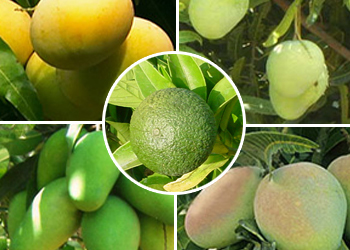Though there are nearly 1000 varieties of mango in India, only following varieties are grown in different states : Alphonso, Bangalora, Banganpalli, Bombai, Bombay Green, Dashehari, Fazli, Fernandin, Himsagar, Kesar, Kishen Bhog,Langra, Mankhurd, Mulgoa, Neelam, Samarbehist, Chausa, Suvarnarekha, Vanaraj and Zardalu.
VARIETIES WE GROW
Alphanso

Alphonso is widely recognised as the best mango variety available. These are small, roundish mangoes with a smooth, pale orange to deep orange peel. The flesh is an intense reddish-orange colour, smooth and almost fibreless. The flavour and sweetness are intense, exquisite, rich and unique, well worth tracking down to your local Indian store.
Ripening:
Buy the fruit when they are still smooth and with a hint of pale green in the peel. Eat when quite tender, even soft, with a deepening orange peel colour.
Harvest Availability:
April to early July
![]()
Kesar

Kesar is India’s second mango variety in terms of exports, but second only to Alphonse which happens to be the best on the planet! Kesar is a small to medium fruit, roundish in shape, and relatively unexciting in appearance, being a dull, slightly mottled yellow colour. Inside it is a different matter: a deep yellow flesh, smooth and fragrant with intense sweetness – you will not be disappointed when they are in peak condition. The medium sized stone has minor fibre attached which does not detract from enjoyment. Fruit medium oblong with a red blush on the shoulders, good keeping quality, ideal for pulping and juice concentrates, early season variety.
Ripening:
Kesar are ready to eat when the fruit is tender with a overall softness coming through the thin peel. Avoid fruit with excessively soft patches, or bruised or compressed areas.
Harvest Availability:
Mid-June to July
![]()
Duseri

Best varieties of the country; fruit size is small-medium, shape is elongated with yellow fruit colour, flesh is fibreless; good keeping quality; mainly used for table purpose; susceptible to mango malformation. Dashehari-51- regular bearing and yielding clone of Dashehari. The flavour and sweetness are exceptional and they appear to be popular with supermarkets, probably because the sources are easier to control.
Ripening:
Dussehara is quite easy to monitor for ripeness as the fruit becomes quite soft and tender when mature, and the peel develops a yellow tinge beneath the red blush.
Harvest Availability:
Mid-June to early July
![]()
Banishan

The skin colour is green, even when ripe, and is overlaid with characteristic corky dots covering the fruit surface. As with most other fine dessert mangos of India, 'Baneshan' is best harvested hard-green and ripened at room temperature. In this manner one can expect an exceptional, multi-levelled flavour, from the deep and resinous to the intensely sweet.
![]()
Citrus Limetta

Citrus limetta is a species of citrus. InIndia, it is commonly called as Moosambi (Kannada) and Bathaya Kaayalu (in Telugu).
The very name citrus forms in our minds several images: a mouth watering acid sweet taste, a refreshing flavour, a soothing drink in fever and illness and, of course, the thirst quenching lemonades of hot summer. Mosambi is a rich citrus fruit also called as Sweet lime and it is an important fruit used for table purpose and juice. The fruits are rich in Vitamin C .Trees start bearing when about 5 to 7 years old. Mosambi trees starts bearing flowers during January /February month and fruits are ready for harvest by August-September. The tree is characterized by ovular, dark green leaves, fragrant white flowers and sweet orange fruit. The plantation yields the maximum when the trees are about 10-20 years old. On an average, each tree yields about 300—1,000 fruits per year. The aromatic principle in these fruits is due to a chemical substance called limonene and other essential oils. All these chemical compounds present in citrus fruits are found to have extensive uses in industry, pharmaceuticals and food processing.
![]()
FACT ABOUT MANGO
Source: Nutrient data for this listing was provided by USDA SR-21. Each "~" indicates a missing or incomplete value.
Percent Daily Values (%DV) are for adults or children aged 4 or older, and are based on a 2,000 calorie reference diet. Your daily values may be higher or lower based on your individual needs.
Nutrition Data's Opinion, Completeness Score™, Fullness Factor™, Rating, Estimated Glycemic Load (eGL), and Better Choices Substitutions™ are editorial opinions of NutritionData.com, given without warranty, and are not intended to replace the advice of a nutritionist or health-care professional.








